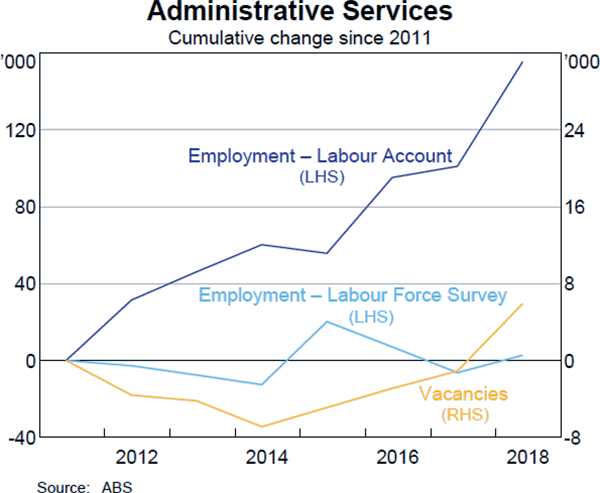Statement on Monetary Policy – February 2019 Box C: New Industry Employment Estimates
The Australian Bureau of Statistics (ABS) has recently introduced an experimental labour market data release called the Labour Account. This pulls together information from separate household, business and government data sources. The Labour Account includes quarterly estimates of employment and jobs by industry, as well as information on multiple job holders and breakdowns of hours paid for ordinary and overtime hours.[1] Prior to the Labour Account release, the only regular estimates of industry employment were from the household Labour Force Survey (LFS). At present, the Labour Account remains experimental and revisions to the data between quarterly releases have been relatively large. While the LFS will remain the best and most timely indicator of overall labour market developments (including employment growth and the unemployment rate), the ABS suggests that the Labour Account is likely to become the primary source of industry employment information.[2]
Estimates of industry employment differ noticeably between the Labour Account and the LFS (Graph C1). The differences in levels are relatively large in the administration & support and accommodation & food industries, and relatively small in the health care & social assistance industry. Reported trends can also differ between the two sources; for instance, the Labour Account suggests that manufacturing employment did not increase as much recently as the LFS reported.

The differences between the industry employment estimates may arise from differences in how households and businesses report their industry. Labour supply firms may be one reason for the discrepancy. These firms supply their own employees to a client's business on a fee or contract basis. The ABS classifies employees of labour supply firms as being employed in administrative services, part of the administration & support industry, although many of those employees report in the LFS that they are working in the industry of their place of work, such as transport or manufacturing. Though administrative services account for around 5 per cent of jobs in the economy, administrative services vacancies have grown strongly over the past four years to account for around 10 per cent of total vacancies. This suggests that labour supply firms may be growing in importance (Graph C2).

The Labour Account's industry employment numbers have a number of potential advantages of over those in the LFS. The industry classification in the Labour Account aligns better with the measurement of industry value-added in the national accounts, and so the Labour Account should contribute to better estimates of industry productivity growth.[3] The Labour Account also takes a more comprehensive approach to estimating the amount of labour employed in each industry, for instance by including the employment of non-resident visa holders.
Given the Labour Account is a new release and is still considered experimental, the Bank will continue to monitor industry employment trends in both releases, as well other sources of information on industry trends from business liaison and business surveys.
Footnotes
Under the Labour Account framework, the number of filled jobs in the economy will exceed the number of employed persons to the extent that some employed people hold multiple jobs. Secondary jobs (two or more jobs) account for around 7 per cent of total filled jobs. [1]
The LFS also provides a longer history of data, from 1978, and more disaggregation of outcomes by demographic group and sub-industry than is currently available in the quarterly Labour Account. [2]
While the industry estimates in the Labour Account rely on business-based surveys, the Labour Account estimates of total employment and jobs in the economy remain largely dependent on household-based sources, in particular the LFS. [3]